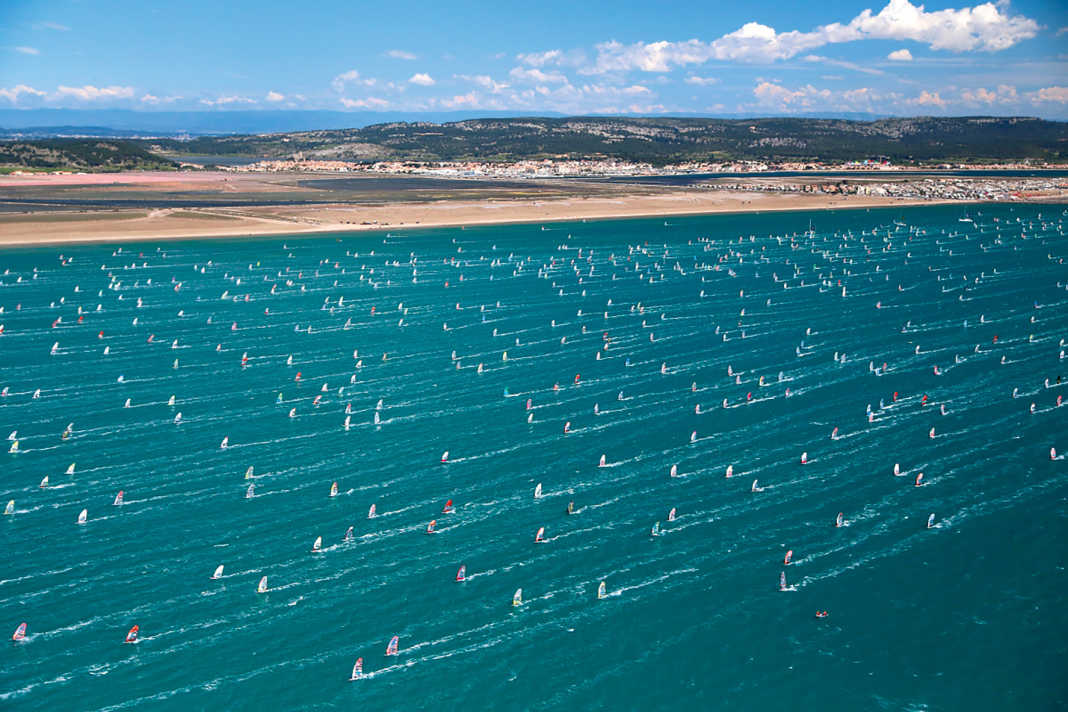



Pierre Mortefon: Know the course and the equipment
The number one thing would be to come and sail upstream at least once, just to get a feel for the water, the wind and the distance if you’ve never sailed in Gruissan (and even if you have, it never hurts to come with Marion and me). Then, to get into the technical side of things, use gear you know and tips number 1 have adjustable harness lines that you can adapt to suit the conditions and your state of fitness.
Funny anecdote: In 2015 we had an incredible edition with a crazy tramontana ! I sailed in 4.7 and 5.2 on all the heats. In the 1st race, the wind was very strong and the battle started right from the start. I was in the top 3, it was very close and we all fell at the jibe, once and even twice. The champions at the head of the race, ridiculous at the jibe! Just a reminder that it’s a real challenge for everyone...
At this point, you will find external content that complements the article. You can display and hide it with a click.
Antoine Albeau: Bigger board and be ready for the start
As far as sailing is concerned, there’s only one watchword for a “normal” windsurfer: choose a bigger board than the one you’re used to, because the wind is really very irregular, especially when you start to cross the crowds of windsurfers.
On land, you need to be well prepared at least an hour before departure, as it’s always difficult to get around and find your equipment on the beach. I have an anecdote on this subject: I had a friend who had prepared well, but when it came time to leave, he couldn’t find his gear! There were so many boards and sails on the beach, it was like a supermarket parking lot. It took him 30 minutes to find it.
Finally, as far as the evenings are concerned, be careful not to get carried away by the atmosphere, or you’ll end up at 4am every night!
At this point, you will find external content that complements the article. You can display and hide it with a click.
Nicolas Warembourg: Test run to get to know the wind
One of the most important points for a successful race, whatever your objective, is to take the time to test the water before the start of the race. I always try to make a few tacks before the first briefing to get a feel for the actual wind conditions. There’s often a difference between what you see from the beach and what you feel on the water.
If you can, prepare 2 or 3 sails before the start. This will save you time if you decide to change equipment before the start.
At this point, you will find external content that complements the article. You can display and hide it with a click.
Marion Mortefon: Check harness lines and enjoy
Here are a few tips to help you get the most out of your sessions:
- Check the condition of your harness lines: If one day you have to come back by force of arms from Port la Nouvelle, you’ll remember! 😜
- Don’t overtrim if the wind is really strong, it’s a long run!
- Enjoy the big windsurfing party: Whether on the water or in the evening during the concerts, this is your chance to experience unforgettable moments with enthusiasts from all over the world. It’s not every day that so many windsurfers gather in one place !
A little anecdote about the race: In general, with the other girls, we don’t see each other much at the start, but once we’ve reached the 1st buoy, we often find ourselves in small groups. I’ve even done heats with Delphine Cousin, where we finished one behind the other, almost neck and neck, after 10 km. It was really fun to be in the middle of all those windsurfers!
At this point, you will find external content that complements the article. You can display and hide it with a click.
Jordy Vonk: Preparation and a good buddy
My best tip for the Défi Wind can be summed up in one word: preparation. It’s the reason we started the ‘Défi Wind Experience’—to help people get ready for what’s to come! When you’re out on the water with 1,500 other windsurfers, it can be overwhelming. Make sure you know the spot, check all your gear at home, and I highly recommend not going alone. Having a windsurfing buddy to share the experience with is incredibly helpful!
Anecdote: To me, the Défi Wind isn’t just a 40-kilometer race—it’s one big festival of windsurfing that includes a race. Enjoy every part of it, especially if it’s your first time. Make sure you experience everything: the race, the party, the stands, the pros, and the people. Soak up as much as possible, learn, and come back next year for maybe a proper result. I’m sure doing the Défi is addictive - at least for me!
At this point, you will find external content that complements the article. You can display and hide it with a click.
